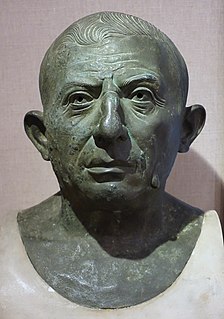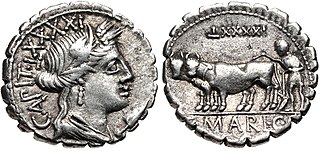Related Research Articles
The gens Terentia was a plebeian family at ancient Rome. Dionysius mentions a Gaius Terentilius Arsa, tribune of the plebs in 462 BC, but Livy calls him Terentilius, and from inscriptions this would seem to be a separate gens. No other Terentii appear in history until the time of the Second Punic War. Gaius Terentius Varro, one of the Roman commanders at the Battle of Cannae in 216 BC, was the first to hold the consulship. Members of this family are found as late as the third century AD.

The gens Porcia, rarely written Portia, was a plebeian family at Ancient Rome. Its members first appear in history during the third century BC. The first of the gens to achieve the consulship was Marcus Porcius Cato in 195 BC, and from then until imperial times, the Porcii regularly occupied the highest offices of the Roman state.
The gens Arria was a plebeian family at ancient Rome, which occurs in history beginning in the final century of the Republic, and became quite prominent in imperial times. The first of the gens to achieve prominence was Quintus Arrius, praetor in 72 BC.

The gens Caecilia was a plebeian family at ancient Rome. Members of this gens are mentioned in history as early as the fifth century BC, but the first of the Caecilii who obtained the consulship was Lucius Caecilius Metellus Denter, in 284 BC. The Caecilii Metelli were one of the most powerful families of the late Republic, from the decades before the First Punic War down to the time of Augustus.
The gens Caecinia was a plebeian family of Etruscan origin at ancient Rome. Members of this gens are first mentioned in the time of Cicero, and they remained prominent through the first century of the Empire, before fading into obscurity in the time of the Flavian emperors. A family of this name rose to prominence once more at the beginning of the fifth century.
The gens Caesennia was an Etruscan family from Tarquinii during the late Roman Republic and in imperial times. Two of its members were mentioned by Cicero, and the name is found in sepulchral inscriptions.

The gens Maria was a plebeian family of Rome. Its most celebrated member was Gaius Marius, one of the greatest generals of antiquity, and seven times consul.

The gens Pomponia was a plebeian family at ancient Rome. Its members appear throughout the history of the Roman Republic, and into imperial times. The first of the gens to achieve prominence was Marcus Pomponius, tribune of the plebs in 449 BC; the first who obtained the consulship was Manius Pomponius Matho in 233 BC.
The gens Luscia was a minor family at ancient Rome. Members of this gens are first mentioned in the early part of the second century BC. They were of senatorial rank, but few of them achieved the higher offices of the Roman state. The only known consul of this gens was Lucius Luscius Ocrea, during the Flavian dynasty.
The gens Manilia was a plebeian family at ancient Rome. Members of this gens are frequently confused with the Manlii, Mallii, and Mamilii. Several of the Manilii were distinguished in the service of the Republic, with Manius Manilius obtaining the consulship in 149 BC; but the family itself remained small and relatively unimportant.

The gens Munatia was a plebeian family at Rome. Members of this gens are first mentioned during the second century BC, but they did not obtain any of the higher offices of the Roman state until imperial times.
The gens Novia was a minor plebeian family at ancient Rome. Members of this gens first appear during the final century of the Republic, but the first of the Novii to obtain the consulship was Decimus Junius Novius Priscus in AD 78.
The gens Numeria was a minor plebeian family at ancient Rome. Few of its members held any of the higher offices of the Roman state.
The gens Oppia was an ancient Roman family, known from the first century of the Republic down to imperial times. The gens may originally have been patrician, as they supplied priestesses to the College of Vestals at a very early date, but all of the Oppii known to history were plebeians. None of them obtained the consulship until imperial times.
The gens Peducaea, occasionally written Paeducaea or Peducea, was a plebeian family at ancient Rome. Members of this gens occur in history from the end of the second century BC, and from then to the time of Antoninus Pius, they steadily increased in prominence. The first of the Peducaii to obtain the consulship was Titus Peducaeus in 35 BC.
The gens Perpernia, also found as Perpennia, was a plebeian family of Etruscan descent at ancient Rome. Members of this gens first appear in history during the second century BC, and Marcus Perperna obtained the consulship in 130 BC.

The gens Saufeia was a minor plebeian family at ancient Rome. Members of this gens are first mentioned in the final century of the Republic, and from then to the early Empire their name occurs regularly in history, but none of them ever attained the consulship.
The gens Seia was a minor plebeian family of equestrian rank at ancient Rome. Members of this gens are first mentioned in the time of Cicero, and a few of them held various magistracies under the late Republic and into imperial times.
The gens Trebonia, rarely Terebonia, was a plebeian family at ancient Rome. Members of this gens are mentioned in the first century of the Republic, and regularly throughout Roman history, but none of them attained the consulship until the time of Caesar.
The gens Trebellia, occasionally written Trebelia, was a plebeian family at ancient Rome. Members of this gens are first mentioned at the time of the Second Punic War, but they played little role in the Roman state until the final decades of the Republic. Trebellii are known from inscriptions in Delos and in Athens between 150 and 89 BC. The most illustrious of the Trebellii was Marcus Trebellius Maximus, who attained the consulship in AD 55.
References
- ↑ Dictionary of Greek and Roman Biography and Mythology, vol. II, pp. 186, 187 ("Fulcinia Gens").
- ↑ Chase, p. 126.
- ↑ New College Latin & English Dictionary, s.v. fulcio.
- ↑ Livy, iv. 17.
- ↑ Cicero, Philippicae, ix. 2.
- ↑ Broughton, vol. I, p. 58.
- 1 2 3 Cicero, Pro Caecina 4, 6.
- ↑ Eckhel, vol. v. p. 221.
- ↑ Broughton, vol. I, p. 461.
- 1 2 Asconius Pedianus, In Ciceronis Pro Milone, p. 54.
- ↑ Tacitus, Annales ii. 28, 30, iii. 10, 19, v. 11, vi. 4, 38.
- ↑ Cassius Dio, lviii. 9, 25.
- 1 2 3 4 Ferguson, Africa in Classical Antiquity, p. 211.